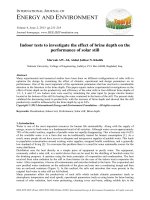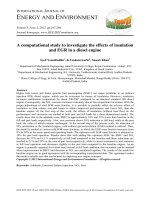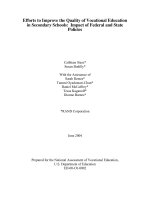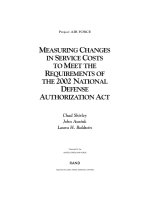To investigate the rate of release of boron from different sources and levels of boron at varying period of incubation
Bạn đang xem bản rút gọn của tài liệu. Xem và tải ngay bản đầy đủ của tài liệu tại đây (457.25 KB, 7 trang )
Int.J.Curr.Microbiol.App.Sci (2018) 7(7): 2963-2969
International Journal of Current Microbiology and Applied Sciences
ISSN: 2319-7706 Volume 7 Number 07 (2018)
Journal homepage:
Original Research Article
/>
To Investigate the Rate of Release of Boron from Different Sources and
Levels of Boron at Varying Period of Incubation
P.J. Rathod* and N.M. Zalawadia
Krishi Vigyan Kendra, Lokbharti gramvidhyapith, Sanosara, Shihor,
Bhavnagar-364230, India
*Corresponding author
ABSTRACT
Keywords
Boron, Sources,
Level, Boric acid,
Borax, Agricol and
incubation
Article Info
Accepted:
20 June 2018
Available Online:
10 July 2018
The time of incubation had the pronounced effect on boron availability. The boron
availability of each product increased up to 45th days of incubation period, and
then it was decreased. Availability of boron seems to have direct relationship with
the quantity of applied boron. Thus, the overall availability of boron increased
with the increasing dose of applied boron sources. Among the different sources of
boron, the rate of release of available boron was highest in Boric acid followed by
Borax and Agricol. The interaction effect of different sources and periods was
found significant. The highest availability of boron was registered at 45 th days of
incubation period with 10 ppm Boric acid treatment.
Introduction
Boron is one of the seven essential
micronutrients required for normal growth and
development of plant. The original source of B
in most soils is tourmaline which contains 34% B. It is quite resistant to weathering hence
the release of B from it is quite slow. Boron
being the only element that is normally
present in the soil solution as a non ionized
molecule (H3BO3) over the pH range suitable
for plant growth. It helps in increasing the
permeability of cell membranes in the plants.
It involves in sugar translocation, metabolism
of carbohydrates and auxin, flower fertility,
cellular activities and chlorophyll synthesis. It
also plays a vital role in protein synthesis and
related to calcium, potassium metabolisms in
plants (Tisdale et al., 1985).
In recent years, the importance of
micronutrients in increasing agricultural
production and correcting deficiencies in
plants has been greatly realized. In India, the
deficiencies of micronutrients have been
observed in the light texture and calcareous
soils. The situation has been further
aggravated with the introduction of high
2963
Int.J.Curr.Microbiol.App.Sci (2018) 7(7): 2963-2969
yielding crop varieties, intensive cropping
system, heavy fertilization with high purity
grade fertilizers and decrease in the use of
bulky organic manures and recycling of crop
residues. The accompanied changes in the soil
management practices also frequently alter the
micronutrient availability. In order to maintain
the level of productivity of the soils, it is
desired to keep the complete account in their
status and changes being taking place with
regards to their substitute and production.
Materials and Methods
Incubation study
The details of experiment are given below.
1.
Design of experiment: Completely
Randomized Design with 63 treatment
combinations.
2.
Treatment: There were three sources
of boron and seven levels of boron and six
period intervals as follows.
(a) Three sources of boron
Symbol
S1
S2
S3
Symbol
L0
L1
L2
L3
L4
L5
L6
(c) Replication
(d) Location
(e) Moisture maintained
Sources
Agricol (Coleminite)
Borax crystals
Boric acid
(b) Seven levels of boron
Levels
0.0 mg kg-1
1.0 mg kg-1
2.0 mg kg-1
4.0 mg kg-1
6.0 mg kg-1
8.0 mg kg-1
10 mg kg-1
: 3 (three)
: U. G. Laboratory, Department of Agril. Chemistry
and Soil Science,
College of Agriculture,
J. A. U. Junagadh.
: At field capacity
Incubation period
There were six different periods of incubation.
The sampling done at the intervals as
mentioned in Table A.
Method of incubation
One kg soil was taken in a plastic bowel and
the soil was treated with seven levels of boron
(0.0, 1.0, 2.0, 4.0, 6.0, 8.0, and 10 mgkg-1) and
three source of boron (Agricol, Borax crystal
and Boric acid) as per treatments in triplicate
at room temperature (27°- 30° C) in the
laboratory. The soil moisture content was
maintained at field capacity of the soil and
loss in water content in soil was made up
throughout the incubation period by addition
the water as determined by the loss in weight
of bowel soils.
Periodical soil sampling at each interval (15th,
2964
Int.J.Curr.Microbiol.App.Sci (2018) 7(7): 2963-2969
30th, 45th, 60th, 75th and 90th) was done with
the help of a plastic tube. The soil sampling
was done from 3 spots of each bowel
considering entire depth of bowel. The soil
was air dried, passed in 2 mm sieve and
analyzed for hot water soluble (HWS) boron.
The incubation study was started on 11th June,
2007 and completed 11th August, 2007.
Results and Discussion
Effect of different sources of boron and
incubation periods on availability of boron
The data regarding the availability of boron as
affected by different sources of boron and
incubation periods are reported in table 1. The
result revealed that the different sources of
boron produced significant effect on
availability of boron. The maximum
availability of boron was registered with Boric
acid (3.57 ppm), while lowest was observed
with Agricol product (0.96 ppm). All the
sources were significant with each other.
Among the different sources, the rate of
release of available boron was highest in Boric
acid followed by Borax and Agricol
treatments.
A close look at this table reveals that there
was an apparent effect of time of incubation
on the availability of boron (Table 1). The
mean values of boron availability for different
time intervals show that there was significant
effect of time of incubation, which increased
the availability of boron up to 45th days
period. Then it was significantly decreased
with all the sources. The maximum
availability was observed at 45th days period
(2.69 ppm) while beyond this period it was
decreased up to 90th days. The lowest
availability was observed at 90th days period
(1.37 ppm). The interaction effect of different
sources and periods was found significant.
The highest (4.57 ppm) availability of boron
was registered at 45th days with boric acid
treatment, while lowest (0.76 ppm) boron
availability was found at 15th days with
Agricol treatment. In the experimental soil, the
trend of change in HWS-B content was found
to record a significant and gradual decrease
with the advancement of incubation period.
Further, at later stages of incubation, greater
amounts of HWS-B content transformed into
some non-exchangeable forms as compared to
early period of incubation. These results are in
line with the findings by Gupta (1968), Khanh
et al., (2005) and Girish Chander et al.,
(2007). The adsorption of boron on clay
minerals and fixation and exchange (Keren
and Bingham, 1994) probably reduced these
available contents in soil. This may be
attributed to fixation and/or complexation of B
with organic and inorganic components of the
soil (Evans and Sparks (1983).
Effect of different sources and levels of
boron on availability of boron
The results of different sources and levels of
boron on availability of boron are reported in
table 2. The different sources of boron
produced significant effect on rate of release
of available boron. The maximum availability
of boron was registered under Boric acid (3.57
ppm), while lowest was observed under
Agricol (0.96 ppm).
The
Agricol
significantly
increased
availability of boron with increase in level of
boron except 1 ppm level, where it was at par
with 0 level of boron. The similar trend was
also observed in case of Borax and Boric acid.
The highest (3.98 ppm) availability was
recorded at 10 ppm level of boron
concentration. The lowest (0.54 ppm)
availability was registered at 0 ppm of boron
concentration.
The interaction effect of level and sources of
boron on boron availability was found
significant. The maximum availability of
2965
Int.J.Curr.Microbiol.App.Sci (2018) 7(7): 2963-2969
boron (7.37 ppm) was observed in Boric acid
at 10 ppm application of boron concentration,
while minimum availability of boron (0.53
ppm) was observed in Agricol at 0 ppm level
of concentration i.e. no application of boron.
It is clearly indicated that the availability of
boron in each source significantly increased
with increase in levels of boron. The
application of boron obvious to increase the
available boron content in soil, Prasad and
Byrne (1975) reported that the boron
concentration significantly improved boron
status in soil. More or less similar results were
also reported by Evans and Sparks (1983) and
Girish Chander et al., (2007).
Interaction effect of boron levels, sources
and incubation periods on boron
availability
The pooled data regarding the effect of boron
levels, boron sources and incubation periods
are presented in Table 3. The pooled results of
interaction over entire period of incubation
showed significant effect. It was found that at
zero level of boron to 10 ppm boron
application with different sources, the
availability of boron increased but the rate of
increase was much higher when boron was
applied @ 10 ppm. It is seen that although the
interaction was significant, the trend of boron
availability at different incubation period did
not found consistent. The trend was almost
similar when the combined effect of boron
sources and boron level was examined at
individual incubation periods.
The interaction of period-source-level was
significant. It is the point to note that when
levels of boron, source and incubation period
increase simultaneously the rate of increase in
availability of boron was more than at any
constant level of factor. The combination of
10 ppm boron, 90th day incubation and boric
acid source increased the availability of boron
by four times compared to the combination of
no application of boron at 15th days of
incubation in Agricol. The availability of
boron increased to a grater extent by
combined application of period, level and
source than varying in levels of any single
factor. These results are in affirmation with
those of earlier workers Keren and Bingham,
(1994); Khanh et al., (2005) and Girish
Chander et al., (2007).
Table.1 Effect of different sources of boron and incubation periods on availability of boron
(ppm)
Treatments
Agricol – S1
15th days
30th days
45th days
60th days
75th days
90th days
Mean
Treatment
S
P
SXP
0.76
0.88
1.40
1.09
0.93
0.68
0.96
S.Em+
0.016
0.018
0.041
Sources of boron (ppm)
Borax – S2
Boric acid – S3
1.04
1.41
2.09
1.87
1.46
1.18
1.51
C.D. at 5%
0.046
0.051
0.124
2966
3.79
4.19
4.57
3.71
2.93
2.24
3.57
C.V. %
10.39
Mean
1.86
2.16
2.69
2.22
1.77
1.37
Int.J.Curr.Microbiol.App.Sci (2018) 7(7): 2963-2969
Table.A Incubation period
Sr.No
1.
2.
3.
4.
5.
6.
Particulars
Fifteen day after application of B
Thirty day after application of B
Forty five day after application of B
Sixty day after application of B
Seventy five day after application of B
Ninety day after application of B
Treatments
15th
30th
45th
60th
75th
90th
Table.2 Effect of different sources and levels of boron on availability of boron (ppm)
Treatments
0 ppm
1 ppm
2 ppm
4 ppm
6 ppm
8 ppm
10 ppm
Mean
Treatment
S
L
SXL
Agricol – S1
0.53
0.55
0.64
0.88
0.94
1.47
1.71
0.96
S.Em+
0.016
0.020
0.044
Sources of boron (ppm)
Borax – S2
Boric acid – S3
0.53
0.56
0.72
1.24
0.83
2.31
1.35
3.32
1.80
4.45
2.45
5.74
2.86
7.37
1.51
3.57
C.D. at 5%
C.V. %
0.046
10.39
0.055
0.124
Mean
0.54
0.84
1.26
1.85
2.40
3.22
3.98
Table.3 Interaction effect of boron levels, sources and incubation periods on boron availability
Incubation periods
Levels of boron
15 day
0 ppm
1 ppm
2 ppm
4 ppm
6 ppm
8 ppm
10 ppm
0 ppm
1 ppm
2 ppm
4 ppm
6 ppm
30 day
Agricol
0.38
0.41
0.52
0.64
0.73
1.22
1.43
0.54
0.48
0.66
0.78
0.75
2967
Sources of boron (ppm)
Borax
Boric acid
0.44
0.46
0.51
1.35
0.62
2.25
0.74
3.07
0.85
4.60
2.00
6.42
2.13
8.38
0.57
0.61
0.63
1.57
0.79
2.51
1.20
3.46
1.90
5.43
Int.J.Curr.Microbiol.App.Sci (2018) 7(7): 2963-2969
45 day
60 day
75 day
90 day
Treatments
SXPXC
8 ppm
10 ppm
0 ppm
1 ppm
2 ppm
4 ppm
6 ppm
8 ppm
10 ppm
0 ppm
1 ppm
2 ppm
4 ppm
6 ppm
8 ppm
10 ppm
0 ppm
1 ppm
2 ppm
4 ppm
6 ppm
8 ppm
10 ppm
0 ppm
1 ppm
2 ppm
4 ppm
6 ppm
8 ppm
10 ppm
1.38
1.57
0.67
0.69
0.82
1.58
1.58
2.16
2.34
0.56
0.62
0.70
0.90
1.07
1.80
2.01
0.54
0.59
0.62
0.77
0.86
1.44
1.69
0.48
0.49
0.52
0.63
0.64
0.82
1.90
S.Em +
0.10
The summary and conclusion are as follows:
An incubation study was undertaken to know
the effect of different sources (Boric acid,
Borax and Agricol) and levels (0.0, 1.0, 2.0,
4.0, 6.0, 8.0 and 10.0 ppm) of boron at
various incubation periods (15th, 30th, 45th,
60th, 75th, and 90th day) on boron availability.
The time of incubation had the pronounced
effect on boron availability. The boron
availability of each source increased up to 45th
2.27
2.48
0.61
0.74
1.20
1.91
2.54
3.48
4.13
0.55
1.30
0.98
1.66
2.27
2.95
3.34
0.53
0.62
0.77
1.39
1.90
2.32
2.70
0.48
0.52
0.62
1.19
1.34
1.69
2.38
C.D. at 5 %
0.30
6.78
8.96
0.67
1.66
2.81
4.31
5.64
7.54
9.35
0.59
0.63
2.49
3.62
4.40
6.01
8.20
0.56
1.17
2.19
3.12
3.69
4.49
5.27
0.46
1.05
1.63
2.32
2.95
3.22
4.06
C.V. %
10.39
days of incubation period, and then it was
decreased. Availability of boron seems to
have direct relationship with the quantity of
applied boron. Thus, the overall availability
of boron increased with the increasing dose of
applied boron sources. The different sources
of boron produced significant effect on rate of
release of available boron. Among the
different sources of boron, the rate of release
of available boron was highest in Boric acid
followed by Borax and Agricol. The
2968
Int.J.Curr.Microbiol.App.Sci (2018) 7(7): 2963-2969
interaction effect of different sources and
periods was found significant. The highest
availability of boron was registered at 45th
days of incubation with 10 ppm Boric acid
treatment.
References
Evans, C. M. and Sparks, D. L. (1983). On
the chemistry and micrology of boron
in pure and in mixed systems. A
review. Commun Soil Sci., Pl. Anal.,
14: 827-846.
Girish Chander, Verma, T. S. and Sharma, S.
(2007). Influence of boron and faryard
manure on available boron and
exchangeable calcium and their
removal by cauliflower in the borondeficient soils of Himachal Pradesh. J.
Indian Soc. Soil Sci., 55(1): 62-66.
Gupta, U. C. (1968). Relationship of total and
hot water soluble boron, and fixation
of added boron, to properties of
Podzol Soils. Soil Sci. Soc. Am. Proc.
32: 45-48.
Keren, R. and Bingham, F. T. (1994). Boron
in water, soils and plants. Edited by
Stewart, B. A. Advances in Soil Sci.,
Published by Springr, Verlay,: 229276.
Khanh et al., (2005) Khanh, V., Kang, Y. and
Sakurai, K. (2005). Boron fixation and
its release in soils and bark compost.
Soil science and plant nutrition. 51(1):
69-74.
Prasad, M. and Byrne, E. (1975). Boron
source and lime effect on yield of
three crops grown in peat. J. Am. Soc.
Agron., 67(4): 553-556.
Tisdale, S. L., Nelson, W. L. and Beaton, J.
D. (1985). “Soil Fertility and
Fertilizer”. 4th ed. MacMillan, New
York.
How to cite this article:
Rathod, P.J. and Zalawadia, N.M. 2018. To Investigate the Rate of Release of Boron from
Different Sources and Levels of Boron at Varying Period of Incubation.
Int.J.Curr.Microbiol.App.Sci. 7(07): 2963-2969. doi: />
2969









